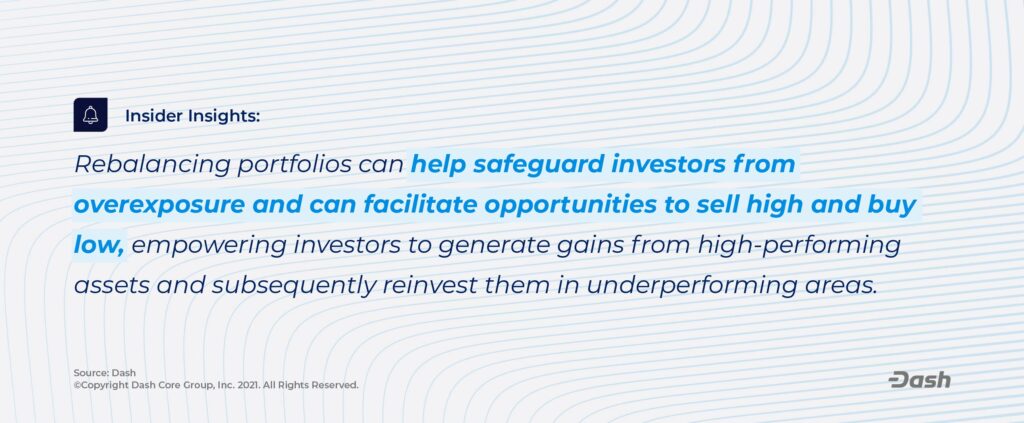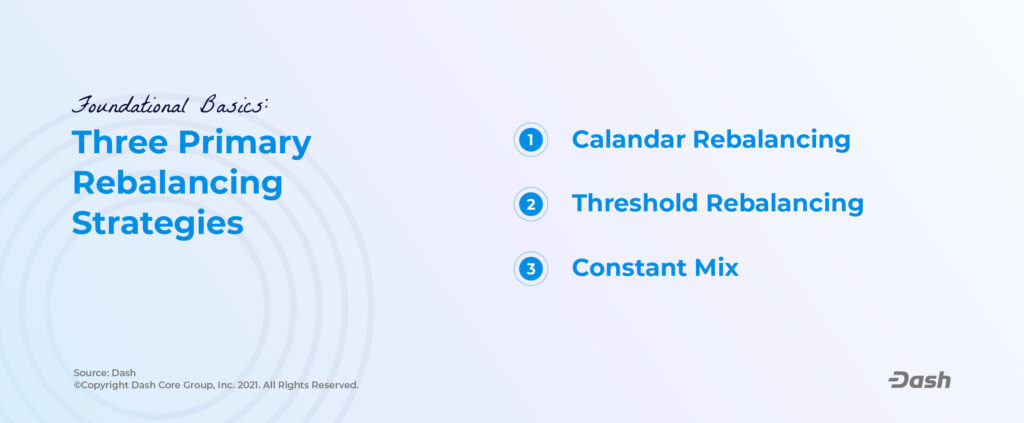 January 9, 2022 2:02 am
January 9, 2022 2:02 am
Portfolio Rebalancing: What Is It and How Does It Work?
Over time, the composition of investment portfolios change. Portfolio rebalancing helps keep an investor’s risk consistent with their goals.
To maintain equilibrium in an inherently volatile market, portfolio rebalancing becomes necessary. This technique is as effective for retirees as it is for young investors.
In this article, we’ll cover what you need to know about portfolio rebalancing, including various strategies to use and when to consider adjusting your crypto portfolio.
What Is Portfolio Rebalancing?
Portfolio rebalancing is the process of harvesting outperformance from one asset class and redirecting them to other asset classes that have not performed as well.
To better understand this concept, consider a hypothetical example in which an investor’s portfolio is comprised of 60% stocks, 30% bonds, and 10% alternatives (including cryptocurrencies).
Six months later, the portfolio shifts due to inflation. The investor now finds their allocations at 75% stocks, 20% bonds, and 5% alternatives.

This isn’t a negative development. Rather, it’s entirely normal for portfolios to get out of balance due to the constant fluctuation of investment prices. Left unattended, however, the shifted allocations could leave the investor exposed to significant drawdowns during particularly volatile periods.
Rebalancing, therefore, is the process of returning a portfolio to its initial allocation structure in accordance with one’s risk appetite.
For the investor in our example to regain their original 60/30/10 allocation, they would need to sell some of the outperforming assets and redirect the proceeds to their underperforming investments.
In this case, the 15% growth in stocks would then be reallocated to the other asset classes.
Portfolio rebalancing is an equally useful technique after sustaining losses as it is for managing outperforming assets. Note that gains are never guaranteed in the market.
How Important Is Rebalancing a Portfolio?
While risk is inevitable in the market, rebalancing portfolios can help safeguard investors from overexposure. Secondly, it can facilitate opportunities to sell high and buy low, empowering investors to generate gains from high-performing assets and subsequently reinvest them in underperforming areas.

Rebalancing also enables investors to adjust their portfolios to meet both their changing risk profile and their ever-evolving financial needs.
Contrary to public perception, rebalancing does not require a standard 60/40 stock and bond split. Rather, true rebalancing allows for a wide range of allocations dependent upon an investor’s financial goals and timeline.
How Often Should a Portfolio Be Rebalanced?
Though there are no official time schedules to follow, it’s commonly recommended to rebalance portfolios at a minimum of once a year.
Many analysts typically encourage a more consistent cadence, as on a monthly or quarterly basis. This approach allows for regular opportunities to rebalance without overreacting to short-term volatility.
On the other hand, instead of selecting a monthly or quarterly structure, you can also choose to rebalance at set allocation points (i.e., when your assets fluctuate past a certain percentage).
For example, some money managers encourage investors to prune asset classes by as little as 5% when targets are overgrown.
How Does Rebalancing a Portfolio Work?
Thus far, we’ve discussed portfolio rebalancing in terms of percentages. To better understand exactly how rebalancing works, let’s look at a simple financial example.
Let’s say you opt for a fairly conservative portfolio with a balance of 50% stocks and 50% bonds.You have $5,000 to invest and put $2,500 in each asset class.
At the end of the year, your stocks have doubled in value, reaching $5,000. While your portfolio is worth $7,500, your allocations are no longer evenly split.
Stocks now represent over 66% of your total investments, while your bonds are under 34%. To rebalance this portfolio at its original 50/50 split, you would then need to reallocate the $1,250 of the gain into high-performing stocks and use the funds to buy more bonds.
Therefore, your portfolio of $7,500 is now $3,750 in stocks and $3,750 in bonds.
What Are Some Portfolio Rebalancing Strategies?

There are three primary rebalancing strategies that investors use:
- Calendar Rebalancing: This approach establishes predetermined time periods to make adjustments. As such, calendar rebalancing typically favors monthly and quarterly assessments over annual and weekly intervals. The rationale holds that annual assessments often allow for excessive portfolio drift, while weekly rebalancing demands exorbitant costs, time, and attention to properly manage. For proponents of this approach, it’s seen as a sweet spot between annually and weekly.
- Threshold Rebalancing: Rather than prioritizing set time periods, this approach involves choosing a threshold for how far allocations can stray before needing adjustment. For example, many thresholds will involve a deviation of +/- 5%. Therefore, if the balance of an asset class exceeds that predetermined threshold, the portfolio will automatically rebalance to match the original target composition.
- Constant-Mix: As opposed to the traditional “buy and hold” approach, the constant mix strategy often appeals to investors who prioritize more consistent interaction with their portfolios. Constant-mix works better in markets that tend to rise-and-fall. This approach also helps ensure that the mix between stocks and bonds never drifts dramatically beyond target weights.
In addition to these core strategies, a truly balanced portfolio also includes a range of alternative investments. As such, cryptocurrencies present an especially compelling addition to modern portfolios.
What Is Crypto Portfolio Rebalancing?
Crypto portfolio rebalancing functions similarly to traditional portfolio rebalancing. Instead of featuring equities and fixed income, however, a crypto portfolio simply features a range of different cryptos — like Bitcoin (BTC), Chainlink (LINK), Ethereum (ETH), Dash (DASH), and others.
There are two primary crypto portfolio rebalancing strategies:
- Threshold Rebalancing: As with traditional portfolios, threshold rebalancing occurs after an asset’s weight exceeds a predetermined value. For example, if a portfolio is 50% BTC and 50% ETH, and the trader set their target threshold at +/- 10%, BTC rising to 60% would signal a need for rebalancing.
- Periodic Rebalancing: Conversely, with periodic rebalancing, traders choose to adjust their portfolios at will. Given the crypto market’s increased volatility, taking a more consistent approach to rebalancing may be advisable.
How Often Should a Crypto Portfolio Be Rebalanced?

Though crypto volatility is no secret, consistent rebalancing can yield significant profits.
One recent study found that increasing rebalance frequency directly increased portfolio performance. In fact, 92% of all portfolios which consistently rebalanced over the course of a year beat the HODL (hold on for dear life) approach. On the whole, rebalancing crypto portfolios beat HODL by a median of 64%.
More recent studies have since confirmed that crypto portfolio results typically improve with more frequent rebalancing.
Is Rebalancing Necessary?
When it comes to rebalancing portfolios, there are convincing arguments on both sides. Proponents of rebalancing point to its reduction of risk and defense against volatility, while detractors regard rebalancing as an overly simplistic strategy.
Such naysayers point to the major stock market index funds and ETFs as evidence that rebalancing remains unnecessary.
Ultimately, portfolio rebalancing depends on your unique financial profile. If you are a young investor with several decades of employment to come, you may be able to manage a riskier portfolio with longer rebalance periods.
Conversely, if you’re a more conservative investor or are already in retirement, rebalancing may offer more immediate value.
For more information, check out the library of resources available on the Dash blog.